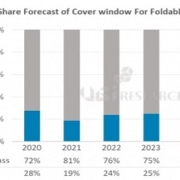Samsung Electronics’ foldable smartphone to be released in 2021, with touch pen and UTG thickness different?
According to the ‘2020 OLED Components and Materials Report’ recently published by UBI Research, Samsung Electronics’ next-generation foldable smartphones to be released in 2021 are expected to be equipped with a pen function.
It is expected that the pen function will be added to Samsung Electronics’ Galaxy Z Fold2, which was released in September, but the flexibility issue of the digitizer, which is an essential material to support the pen function, and ultra thin glass (UTG), the cover window material. The pen function was not added in the end due to its thin thickness.
In order to add a pen function, Samsung Display seems to be considering applying an active electrostatic solution (AES) method that does not require a digitizer and changing the thickness of UTG.
First, the’Galaxy Note’ series uses an electro-magnetic resonance (EMR) method with a digitizer at the bottom of the OLED panel. The EMR method has good touch sensitivity and does not require a battery to be embedded in the pen, but it is not applicable to foldable devices due to the flexibility issue of the metal digitizer.
Unless the companies developing the EMR method provide a special solution, the AES method is highly likely to be applied to the pen for the next ball double device. In this case, the sensor pitch of Y-OCTA is formed more densely or the Touch IC is more complex. Can be designed.
The AES method is also being developed by LG Display and BOE to apply to foldable devices.
In addition, the thickness of UTG is also expected to change. The 30 um thick UTG, which is currently commercially available, has good flexibility, but due to its film-like characteristics, when pressure is applied with a touch pen, traces remain and may affect touch sensitivity. To solve this problem, Samsung Display is developing UTG with a thickness of more than 60 um in cooperation with glass processing companies.
As the thickness of the UTG decreases as the thickness increases, it is expected that the UTG currently under development will be applied with a concept in which the folded part is processed thin and filled with a material having the same refractive index as glass. In addition, in the future, there is a possibility that an additional coating process will be added after the reinforcement process without a protective film such as PET on UTG.
In UBI Research’s ‘2020 OLED Parts and Materials Report’, Samsung Display’s expected change in foldable OLED was written as a roadmap and the trends of related materials were analyzed. According to the report, Samsung Electronics’ application of pens for foldable devices is expected in 2021, and UTG materials are expected to lead the market at 78% by 2025 in the future cover window market for foldable devices.




